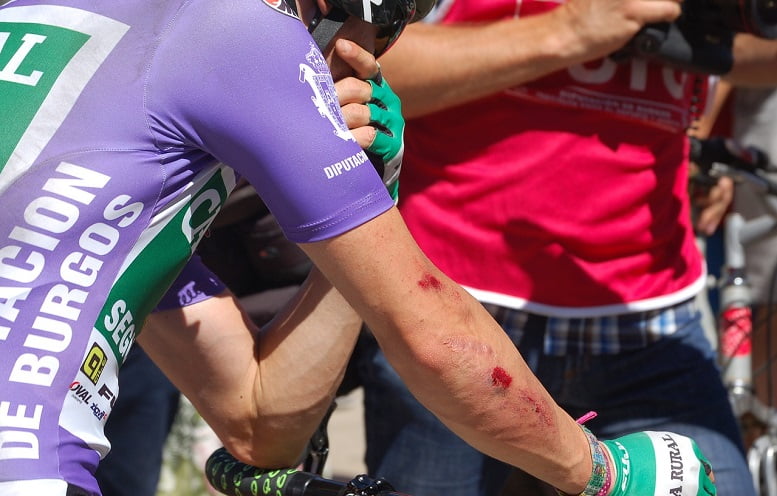Last Updated on August 11, 2022 by Editorial Staff
It is heart-breaking to be forced off the bike due to an injury. Sadly, getting injured is part and parcel of the cycling life. At one moment, you may be enjoying a ride and endure excruciating pain in the next to pedal the bicycle for a few kilometers.
There are different types of cycling injuries which differ in the magnitude of damage that they cause on the body. The good news is that you can recover from most injuries and go back to riding. Here are the most common cycling injuries and tips on how to recover from them.
1. Impact Injuries
Impact injuries occur when a cyclist crashes. They are the most unexpected types of injuries, and when they occur, you should seek immediate medical attention. With impact injuries, you cannot predict the specific parts of the body that will be affected. Sometimes the ones that are deemed safe can be badly affected. On the other hand, some injuries may not be visible. The impact might have caused internal bleeding or broken bones. If your head bore the brunt of the crash, you may suffer a concussion. Another common injury from a bicycle crash is a broken collarbone and road rash.
Recovering from impact injury: If you hit your head and suffer a serious concussion, you need to take proper rest. Do not be in a rush to get back on the bike. A proper bed rest accompanied with some pain relievers can reduce the effects of the concussion. There are special medications that are meant for dealing with this condition. You can treat a broken collarbone using turbo trainer. For road rash, you need to clean the affected part of the body, then apply an antiseptic cream on it. Impact injuries can have a damaging effect on your confidence levels. It is, therefore, important to take some time and reflect on the crash and learn from your mistakes.

2. Lower Back Pain
Curling on the handlebars for many hours can result in pain on your lower back. To make the matter worse, you will head straight to your working area after getting from the bike. Since most of our jobs dictate that we use desktop computers or laptops, you will continue bending. Back pain will have a direct impact on your muscles, making you change your posture. The effect of back pain can extend to other parts of the body such as hips and toes.
Recovering from back pain: If you are experiencing acute pain in your lower back area, take a good rest. You can also use a foam roller to stretch your back and legs. Even after recovering, you need to prevent the re-occurrence of lower back injury. One way of doing this is by assuming a less aggressive position when sitting on your bike. This can be achieved by raising the handlebars. When at work, invest in pillows that can help you sit upright. You should also strengthen your core so that they become strong enough to support your lower back.
3. Knee Pain
This is another common injury that affects most cyclists. For a fast and effective riding, cyclists always fasten their feet on the pedals using shoe cleats. A problem can occur if these cleats are not positioned correctly. The part of the body that is likely to be affected by such a wrong positioning of the cleats is the knee cap/patella which brings about a sudden sharp pain. If you notice some pain on your patella, seek immediate treatment before it graduates into something big.
Recovering from knee pain: Recovering from knee pain involves simple steps that you can implement while at home. First, you need proper rest. This will give your muscles the time to relax. Secondly, consider having some massage sessions on the knee. Applying an anti-inflammatory on the knee can calm down the nerves and reduce the pain. Ice and foam rolling can also help to reduce the intensity of the pain.
4. Hot Foot
Hotfoot, also referred to as foot pain is characterized by a burning sensation on the lower side of the feet. Sometimes the feet become completely numb. This condition is usually caused by the pressure that you exert on the nerves that are connected to the toes. The enclosure created by the cycling shoes means that all the pressure will remain within the shoes. Wearing shoes that don’t have breathing space can make the pain to be worse. Wrong placement of cleat can also lead to hot foot.
Recovering from hot feet: The easiest way of recovering from hot feet and avoiding its reoccurrence is by buying the correct type of shoes. Don’t just buy anything that is labeled ‘cycling shoes’. Ensure that the shoes have some breathing room. If a hot foot is affecting you during summer, it means that your feet are becoming bigger than the shoe size. The best option is to loosen them to create some space. If the hot feet problem affects you during winter, buy thin socks or wider shoes.
5. Neck Pain
Apart from changing the distribution of weight on the muscles, cycling changes the alignment of the neck. Since you need to see where you are going, the neck may develop some fatigue. The pain can be persistent, especially if you ride continuously for hours. It can lead to a condition known as Shermer’s Neck.
Recovering and prevention from neck pain: Taking an off from riding can help the neck to go back to its original form and you will feel less pain. A little massage around the neck can go a long way in easing the pain. You will also need to make various changes on your bicycle. For instance, you can increase the handlebar height so that some of the weight will be redistributed from the neck to other muscles. You may also decrease the reach by bringing the bars closer to the saddle.
The above are the five common cycling injuries that one can get. As we have seen, most of them are preventable and treatable. This means that you don’t need to fear to cycle because regular cycling has a lot of benefits and many positive impacts. However, embrace the prevention and recovery tips that we have discussed.
